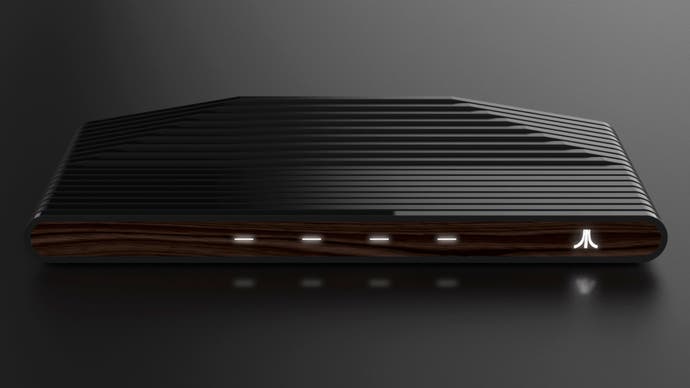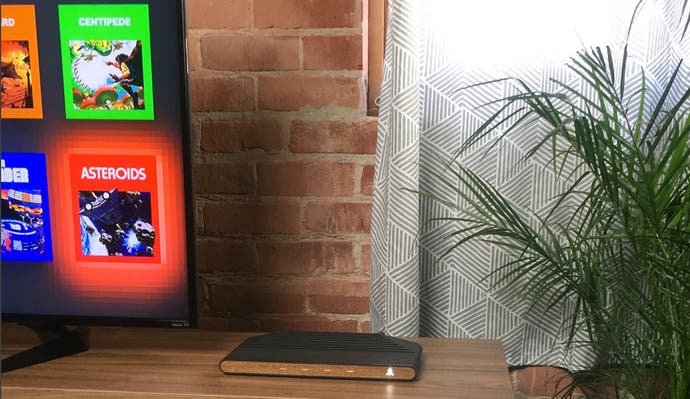Ataribox: Ouya 2.0, evolved Steam Machine or something more?
What would it take for PC hardware to challenge consoles in the living room?
Atari broke cover this week, revealing more about its planned console, dubbed Ataribox. Useful detail is thin on the ground, but we know that it's using a custom AMD processor, that it's based on the open source Linux platform and will cost a minimum of $250. So just what can we expect from the machine - and by extension, can PC technology ever dominate living room gaming?
Despite the lack of a detailed spec, there are some Ataribox takeaways we can glean from the limited and somewhat contradictory info we have. For example, Venturebeat's article says that "the machine can run the kind of games that a mid-range PC can do today, but it won't run triple-A games that require high-end PC performance" - a description that doesn't help much when most triple-A 'high-end' games are built with scalability in mind and can run reasonably well on a mid-range PC with strategic settings tweaks in place.
However, despite the scant facts, the choice of AMD as a partner, the mooted price-point and the crowdfunded nature of the project can allow us to put the project into context. First of all, we shouldn't read too much into Atari's claims of a custom AMD processor. Designing an APU or even tweaking an existing one requires millions of dollars in R&D - and further financial outlay in validating custom silicon. More likely is that Atari is taking an off-the-shelf processor and using it in a different way - even liberating it from its standard socket and mounting it directly onto the motherboard could count as a 'custom' design, after all.
There are other customisation options available too, though we are moving into purely speculative territory here. For example, one aspect of AMD's APU design that Anandtech unearthed a while back is the inclusion of GDDR5 memory controllers on the last-gen Kaveri processor. Totally dormant when used as a desktop part, these controllers could allow for much faster memory to be paired with the chip - exactly as seen on PS4, PS4 Pro and Xbox One X. After all, one of the major disadvantages of AMD's desktop APUs has been the graphics core's reliance on DDR3 and DDR4 system memory, which often leaves the onboard GPU starved of bandwidth.

In terms of the actual AMD part Atari may be using for its console, we should be managing expectations. Speculation has pointed to the latest APUs on the market now as potential candidates for the device, while excited forum posters have suggested that the next-gen Raven Ridge, which combines AMD Ryzen CPU cores with Radeon Vega graphics tech, may be integrated into the hardware.
Our money would be on a low-power, more mobile-orientated part - for a number of reasons. First of all, there's the price-point. Atari would not have access to the kind of mass buying power that Microsoft and Sony have, meaning that higher-end APUs would take a significant chunk out of the $250 baseline price, before we've factored in memory, storage, mainboard, casing and other costs. Secondly, assuming the renderings of the chassis we've seen are accurate, the machine is smaller than a PS4 Slim, limiting the kind of cooling solution that can comfortably fit inside. The more powerful the processor, the more heat it generates and by extension, the larger the cooler needs to be.
In terms of the software the machine runs, Atari is very noncommittal here, its mock-ups only showing Atari 2600/VCS titles, presumable running under emulation. Suffice to say that using an AMD processor to get the job done here is massive overkill. The question is what Atari's ambitions are going forward. In the Venturebeat interview, Atari talks about low-power games like Minecraft and Terraria - even AMD's abandoned low-power Kabini processors using the same Jaguar cores as PS4 and Xbox One (albeit far less capable Radeon GPUs) would get the job done here. But fundamentally, those games are already available on the consoles, so classic Atari emulation aside, the firm seems to be banking on the open platform nature of the box - and possibly the library of SteamOS titles that should be instantly compatible with the machine.

Atari may surprise us of course, but short of a radical hardware design using modern AMD parts, it's difficult to see beyond a box selling for PS4 money that won't offer PS4 performance. But on a more general level, it does beg the question of why the PC format has failed to make that much of an impact on living room gaming. The SteamOS/Steambox initiative failed, while brands like Alienware have backed away from devices like the excellent X51, which packed a scalable, powerful PC design into a console-shaped box, leaving the cute but ultimately underpowered Alienware Alpha for living room duties.
Cost is undoubtedly an issue. All the current living room PC contenders usually opt for the Intel/Nvidia combo, propelling a small form-factor unit to stratospheric cost levels in a world where a PS4 with FIFA 18 is yours for less than £200. Secondly, there's a distinct lack of the unifying interface that the consoles have. In the PC space, GeForce Experience may be the best we have in terms of one single front-end that can launch all of your games, no matter whether they're on Steam, GOG, Origin or uPlay.
But really, it comes down to a lack of will from the key players. It'll take the major movers and shakers in the PC graphics space to create a game-changing reference design. Take a look at the hardware make-up of a mainstream GPU like the RX 580. It has the graphics hardware (obviously), but beyond that it also has fast memory, state-of-the-art AV outputs and dedicated media blocks. All that's missing is the CPU, storage and some USB ports. In a world where the pre-mining boom RX 480 cost £200, an enhanced Vega APU paired with GDDR5 could be relatively inexpensive and perform beautifully as a living room-based Windows machine. Ultimately though, would AMD want to do anything to jeopardise its semi-custom hardware design business, particularly when its own financials remain relatively precarious?
Nvidia has no shortage of funds but lacks an x86 license, so any parallel attempt to crack the living room would be more of a console than a console/PC hybrid, marrying ARM CPU cores with GeForce graphics. Obviously, the firm has ample experience in creating full SoCs (system on chip) and its collaboration with Nintendo and the creation of its NVM graphics API has transformed the performance level of the mobile-orientated Tegra processor. If the Tegra X1 can produce results like Fast RMX, we can only wonder what GTX 1060-level could achieve when developers have direct to-the-metal access to the hardware. Nvidia big cheese Jen-Hsun Huang is also publicly discussing the eventual replacement of the CPU by the GPU, but whether Nvidia itself will take the next step in tackling living room PC gaming remains to be seen: right now, it sees its PC GeForce products as console competitors - though Switch apart, the living room is somewhat under-represented by the firm. Huang does make an interesting point on the PC cost issue though.
"The average selling price of the NVIDIA GeForce is about a third of a game console. That's the way to think about it. That's the simple math. People are willing to spend $200, $300, $400, $500 for a new game console, and the NVIDIA GeForce GPU PC gaming card is on average far less," he says. "But the way to think about that is ultimately that's the opportunity for us. I think GeForce is a game console. And the right way to think about that is at an equivalent ASP of some $200 - $300, that's probably potentially an opportunity ahead for GeForce."
That's just the GPU though. Short of direct action in the market by AMD or Nvidia, it is down to the user to create his or her own console-like PC box to house the replaceable graphics hardware. A mini-ITX based system based on the Intel Coffee Lake platform with a six-core i5 has the potential to last for years, with the GPU potentially the only major upgrade required. With consoles moving to an iterative upgrade path as opposed to the traditional generational leap, maybe the time has come for a more concerted challenge from the PC market sector. But it's going to take more than just a great hardware solution - having spent an afternoon resetting Forza Motorsport 7 on PC owing to continual black-screen issues, it reminds us that the consoles' inherent strengths in plug and play gameplay can't be understated.
As for the Ataribox? Fundamentally, if Atari wanted to deliver a nostalgia-driven emulator experience, there are far cheaper ways to get the job done - as our SNES mini teardown demonstrates. Atari seems to be aiming for something more, but with indie gaming so prolific on consoles already, and with the new box unable to run the most demanding games, a baseline $250 box could be a hard sell. But with so little known about the machine right now, we look forward to finding out more.










